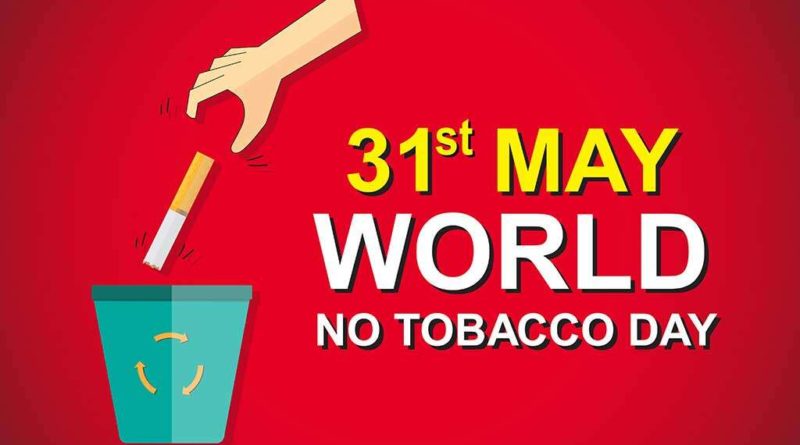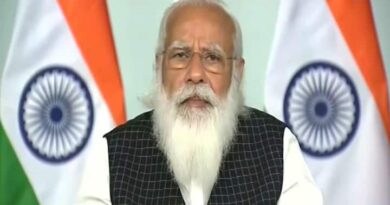Anti Tobacco Day: Its Need, Relevance, Theme, Quotes
World no-tobacco day is observed on 31st May. In order to make people aware of all the troubles and health complications caused by chewing or smoking tobacco, to make people around the world tobacco free and healthy and to avoid all health hazards, Anti Tobacco Day was started by the World Health Organization for the first time to commemorate the program.
To make the whole world free from disease and problems related with tobacco, various other health related programs are also organized by WHO like AIDS Day, Mental Health Day, Blood Donation Day, Cancer Day etc, events are organized and celebrated all over the world. It was first celebrated on the anniversary of the WHO on 7 April, 1988 and later on 31 May was announced to celebrate Tobacco Day every year. It was created in 1987 as World Tobacco Prohibition Day by the member states of WHO.
It is celebrated with the idea of promoting and creating awareness from all over the world to completely stop or reduce the use of tobacco in any form. The goal of this very day is to attract the attention of people globally to spread the message of the harmful effects of tobacco use along with its complications. Many global organizations are involved in this campaign such as state government, public health organizations etc., organizing various types of local public awareness programs.
The habit of nicotine is very harmful to health, which is fatal and is known as brain “deficiency” disease which can never be treated, although it can be arrested completely. Like other illegal drugs, meth, alcohol, heroin, etc. this brain blocks the dopamine pathway. Like other survival activities like eating and drinking food and fluid, it prepares the mind to send the wrong message about the need for nicotine for the body.
There are various ways available to get rid of nicotine addiction by health organizations to help those already on the earth to save their lives. The promotion, advertising and sponsorship of its products or tobacco have been banned by the WHO through the “Tobacco-Free Youth” message campaign and during the 2008 World Tobacco Prohibition Day.
How World No Tobacco Day is celebrated
World Anti-Tobacco Day is organized on an annual basis by non-governmental and government organizations, including the WHO and its member states, to make people aware of all health problems caused by tobacco use.
Some of the activities that are performed to celebrate this day are public marches, exhibition programs, putting up big banners, advertising campaigns through educational programs, direct communication with the general public to stop smoking. The activities do also include organizing meetings, marches, public debate, tobacco prohibition activities, folk arts, health camps, rallies and parades, implementing new laws to prohibit tobacco in certain areas and more, which will help in making the country tobacco free. It has not been declared as a public or official holiday, however, it is celebrated with a lot of impressive campaigns.
It is very important to ban or curb the use of tobacco globally as it causes many diseases such as chronic obstructive lung disease (COPD), lung cancer, heart attack, stroke, permanent heart disease. , Emphysema, various types of cancer, etc. Tobacco can be consumed in many forms such as cigarettes, cigars, bidis, creamy tobacco colored (tooth paste), critex, pipes, gutka, chewing tobacco, surti (hand-stool tobacco), tobacco Colored items, water pipes, snus etc. That is why it is very important to stop the use of tobacco products.
According to the growing demand, a resolution was passed by the WHO on 15 May 1987 to celebrate an annual event called World Tobacco Prohibition Day on 7 April 1988, “a ban on the use of tobacco”, which was later passed on 31 May, 1989 by World Tobacco. On May 17, 1989, to celebrate as Prohibition Day, it was further changed according to the second resolution.
The general public including government and non-governmental organizations are actively involved in celebrating World Tobacco Prohibition Day to draw attention of other people to the health problems caused by tobacco use. People actively use different types of symbols to attract people to the festival to participate actively. Some symbols are clean ester with flowers, highlighting the main body parts harmed by tobacco use (eg heart, lung, kidney etc.), displaying signs of tobacco prohibition, showing brain death due to smoking, internet Displaying direct or indirect posters by using, blogs etc. to make people aware through other means.
The WHO is the main organization that acts as a central hub for organizing World Tobacco Prohibition Day all over the world. The award ceremony is also organized by the WHO since 1988 to promote the various organizations and personalities who actively contribute to this campaign in reducing tobacco consumption and make a surprise contribution to any country and region during this award ceremony. Organizations and individuals of the country are awarded with recognition certificates.
Why Anti-tobacco Day is celebrated and its history
To promote and encourage the general public to ban or reduce the consumption of tobacco or its products, the main goal is to celebrate World No Tobacco Day as it leads us to some deadly diseases like (Cancer, heart problems) or even death. Individuals from different regions of the country, non-profit and public health organizations participate very actively in campaigning for global success and are involved in advertising, new themes and bad effects of tobacco use or its smoking products. Posters are displayed at various places to make people aware of the harmful effects of consuming tobacco.
To make its campaign effective, WHO creates a special theme of the year related to World Tobacco Prohibition Day. Along with making the environment pollution free, this program plays a big role in drawing the attention of the people and government towards the real need of all effective steps to reduce the tobacco consumption globally.
Every year at least one in 10 people die due to the consumption of tobacco, while 1.3 billion people worldwide use tobacco. By 2020 itself, we can control the untimely deaths of about 100 million people by reducing tobacco use by 20-25%, which is possible by implementing all anti-smoking efforts and steps such as banning television or radio advertisements for tobacco, starting a new and effective public awareness campaign showing the dangers and stopping smoking at public places.
It was noted that 50% of men in China smoke. The government of every country needs to take some important steps at the national and regional level to reduce the impact of this bad situation. This can be done through anti-smoking policies such as taxing tobacco, limiting the sale, purchase, advertising, promotion and sponsorship of tobacco and its products, organizing public health camps to assess the dangers of smoking, etc.
Steps / Events taken by WHO on World No Tobacco Day
The WHO has taken several steps to prevent or reduce the use of tobacco or its products globally through various other health awareness campaigns and the establishment of a program called World Tobacco Prohibition Day. Some special steps have been taken by WHO towards not consuming tobacco, which are given here:
An event called “World Tobacco Prohibition Day” was commemorated on 7 April in 1988 on its 40th anniversary with the goal of sensitizing and requesting tobacco users around the world to quit or reduce tobacco use. In 1987, the WHO passed the proposal in the name of WHA 40.38.
• A second resolution called WHA 42.19 was passed by the WHO in 1988 to commemorate a program called World Tobacco Prohibition Day annually on May 31. It also supported the festival by organizing various events and tobacco-related topics.
• In 1998, a second program called the Tobacco Free Initiative (TFI) was set up with the goal of focusing attention on international resources as well as focusing on the global health problems of tobacco use. It has helped in formulating health policies for the people globally for effective tobacco control.
• WHO FCTC is a second public health treaty accepted globally in 2003 as an agreement to implement policies to end tobacco use.
• WHO announced a ban on tobacco advertising, sponsorship and publicity on the eve of World Tobacco Prohibition Day in 2008 by creating a “Tobacco-Free Youth” goal.
World No Tobacco Day Theme
To celebrate World Tobacco Prohibition Day in an effective manner throughout the world, the WHO selects a particular topic every year as a central part to spread a global message to the people for greater awareness. Other promotional items such as brochures, posters, flyers, press releases, websites, etc. are also made available by the WHO to members of the World Tobacco Day celebrations.
The themes from 1987 to 2019 are mentioned below:
• The theme of the year 1987 was “First Smoking-Free Olympics (1988 Olympic Winter – Calgary).”
• The theme of the year 1988 was “Tobacco or Health: Choose Health”.
• The 1989 theme was “Tobacco and Women: Women Smoker: Increasing the Risk.”
• The theme of the year 1990 was “Childhood and youth without tobacco: Growing up without tobacco.”
• The 1991 theme was “Public Places and Transport: Make it Tobacco.”
The theme of the year 1992 was “Tobacco Free Workplace: Safe and Healthy”.
The theme of the year 1993 was “Health Services: Our Window to a Tobacco Free World.”
• The 1994 theme was “Media and Tobacco: Send the Message All Over.”
• The theme of the year 1995 was “More than you think, tobacco costs more.”
The theme of the year 1997 was “Unite for a Tobacco Free World”.
The 1998 theme was “Growing up without tobacco.”
The theme of the year 1999 was “Leave the box behind”.
The theme of the year 2000 was “Tobacco kills, don’t be stupid.”
• The theme of the year 2001 was “Smoke received from others”.
The theme of the year 2002 was “Tobacco Free Sports”.
The theme of the year 2003 was “Tobacco free film, Tobacco free fashion.”
The theme of the year 2004 was “Tobacco and Poverty, a sinful circle.”
The 2005 theme was “Health professionals against tobacco.”
The theme of the year 2006 was “Tobacco: Death in any form or disguise”.
• The theme of the year 2007 was “Tobacco Free from Inside”.
The theme of the year 2008 was “Tobacco Free Youth”.
The 2009 theme was “Tobacco Health Alert.”
The theme of the year 2010 was “Gender and tobacco with emphasis on trade for women”.
• The 2011 theme was “WHO Framework Conference on Tobacco Control.”
The 2012 theme was “Tobacco Industry Intervention.”
• The 2013 theme was “Ban on tobacco advertising, promotion and sponsorship”.
• The theme of the year 2014 was “Increase taxes on tobacco”.
• The theme of the year 2015 was “Stop illegal trade in tobacco products.”
The theme for World Tobacco Prohibition Day in 2016 was “Get ready for plain packaging”.
The theme for World Tobacco Prohibition Day in the year 2017 was “Tobacco – A Threat to Development”.
The theme for World Tobacco Prohibition Day in the year 2018 was “Tobacco and Heart Disease”.
The theme for World Tobacco Prohibition Day in the year 2019 was “Tobacco and Lung Health”.
World Anti-tobacco Day Quotes
• “Quitting tobacco is the easiest thing in this world. I know because I have done this a thousand times. ”- Mark Twain
• “Tobacco kills, if you die, you will lose a very important part of your life.” – Brooke Shield
• “The real face of tobacco is sickness, death and fear – not the brightness and artificiality that the tobacco industry’s drug peddlers try to show us.” – David Birn
• “Excessive smoking kills a living human and saves a dead pig.” – George D Prentice
• “The best way to quit cigarettes is to stop it immediately – no ifs, ands or buts.” – Edith Zittler
• “Cigarette is the killer who travels in the box.” – unknown author
• “Tobacco is a dirty habit like I am dedicated to narrating.” – Caroline Halbrun




